「Syringoma」についての記事まとめ
2023/10/17
院長ブログトップ > The Mysteries of Syringoma: Understanding Its Nature and the Innovative Treatment “Agnes”
The Mysteries of Syringoma: Understanding Its Nature and the Innovative Treatment “Agnes”
Have you ever noticed tiny bumps around your eyes? They aren’t pimples. While they might look like acne at first glance, they don’t pop when touched. Attempting to cover them with makeup can even make them stand out more. Many may have been told by doctors that “treatment is difficult.” These are likely syringomas. While we’ve discussed them in a previous blog“Bumps Around the Eyes: What Are They? ①Could it be Syringoma?”, this post introduces a new treatment method for facial bumps (like syringoma, milia, eccrine hidrocystomas, and sebaceous hyperplasia) named “Agnes.”
What Exactly is Syringoma?
Syringomas are benign skin changes, small wart-like growths, caused by the excessive proliferation of eccrine sweat gland cells. They don’t cause pain or itching, and they won’t worsen over time. However, once they appear, they seldom disappear naturally. While they predominantly appear around the eyes, they can manifest on other parts of the body as well. This condition, more common in women, might have a genetic component, but the exact cause remains unknown.
Concerns with Syringoma
Many mistake syringomas for acne or wrinkles when they first appear. Thinking they’ll go away if popped like a pimple, some might attempt self-treatment, which can exacerbate the problem. Some can grow up to 5mm in size, becoming difficult to conceal with makeup. Understandably, many are concerned about their appearance.
The True Nature of the Bumps Commonly Found Around the Face and Eyes
Common bumps that often appear on the face and around the eyes include syringomas, milia, eccrine hidrocystomas, and sebaceous hyperplasia. Below are simple ways to differentiate these bumps:
①Syringomas
Appearance: Small, flat, flesh-colored bumps that are 1-3 millimeters in size.
Characteristics: Uniform color with a smooth surface.
Location: Usually on the lower eyelids and cheeks.
②Milia
Appearance: Small, hard bumps that are white or yellowish and are 1-2 millimeters in size.
Characteristics: Hardness similar to keloids and a pearl-like appearance.
Location: All over the face, especially around the eyes.
③Eccrine Hidrocystomas
Appearance: Small cystic lesions containing clear or pale blue fluid.
Characteristics: They may enlarge in hot weather or humid conditions.
Location: Primarily on the face, especially around the eyes.
④Sebaceous Hyperplasia
Appearance: Soft, shiny bumps that are flesh-colored to slightly yellowish.
Characteristics: The central part often appears indented.
Location: On the face, especially on the forehead and cheeks.
The Revolutionary “Agnes” Treatment Features
Conventionally, carbon dioxide lasers were used to treat syringomas, milia, eccrine hidrocystomas, and sebaceous hyperplasia. However, these lasers come with a longer recovery time and a risk of scarring. Enter the new treatment method, “Agnes”:
RF Energy: Agnes is a device capable of precisely delivering RF (radiofrequency) energy to specific skin depths. This energy can selectively cause thermal injuries to targeted tissues or sebaceous glands, causing them to coagulate and disintegrate.
Selective Treatment: As Agnes targets specific tissues, it can treat without damaging surrounding healthy skin.
Effective Results: For syringoma treatment, ultra-fine needles deliver RF energy directly to the tissue, destroying it. This can reduce the size and number of syringomas.
Minimal Downtime: Using ultra-fine needles causes minimal skin damage. The pinprick heals quickly, with almost no post-treatment downtime. However, redness, swelling, and minor scabs may persist for a few days.
Prevention of Recurrence: Treatment with Agnes has a lower recurrence rate as it can effectively destroy the targeted tissue.
Safety: When operated correctly, Agnes is considered highly safe. However, it’s crucial that it’s operated by trained medical professionals.
Versatility: Agnes is not only effective for syringomas but also for milia, eccrine hidrocystomas, and sebaceous hyperplasia. Hence, it’s possible to address multiple facial bumps in one treatment session.
Procedure of Agnes Treatment for Syringoma
①Topical Anesthesia: Apply an anesthetic cream and leave it on for about 30 minutes.
②Remove any excess anesthesia and disinfect the treatment area.
③Use ultra-fine needles to access the affected area directly and treat with RF.
④After the treatment, apply an anti-inflammatory ointment for several days.
Post-Treatment Changes and Care
After treatment, the surrounding tissue might swell, making the syringoma more prominent temporarily. However, they will gradually decrease in size, with noticeable shrinkage in 2-3 months. Use gentle face cleansers for a few days post-treatment and avoid skincare products with alcohol. Makeup application is possible from the next day. Notably, side effects from this treatment are minimal. Any swelling or redness is temporary and fades quickly.
Frequency and Progress of Agnes Treatments
While syringomas and facial bumps will certainly reduce in size with Agnes treatment, they might not disappear entirely in one session. These bumps will gradually reduce with each session. While smaller ones might satisfy patients after one session, we generally recommend around three treatments spaced 2-3 months apart.
Before and After Photos of Syringoma Treatment with Agnes
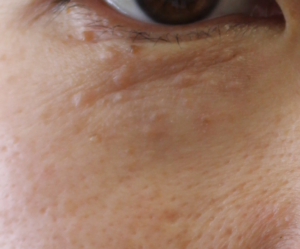
The above photo shows syringomas before treatment.
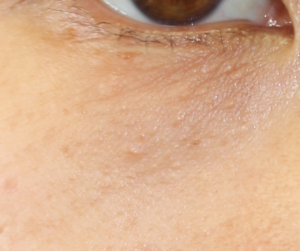
The above photo shows syringomas after treatment.
Other Common Questions Answered!
Can syringomas be treated with traditional Chinese medicine or topical creams?
→ They generally aren’t effective.
What’s the surprise effect of Agnes treatment?
→ It’s also effective for treating fine wrinkles! It tightens the skin, making it effective for wrinkles around the eyes.
Feedback after Receiving Agnes Treatment
This is feedback from the patient in the aforementioned before-and-after photos:
①What prompted you to get the Agnes treatment and what were your concerns before the procedure?
→”Bumps on my forehead and under my eyes.”
②Why did you choose this clinic?
→”I found it on the internet.”
③Tell us about the consultation and the information you received before the Agnes treatment. How did you feel about it?
→”It was easy to understand, which made me want to undergo the procedure.”
④Tell us about the Agnes procedure – its content, the pain, the duration, etc.
→”It was more painful than I thought. The procedure was quick.”
⑤Describe your experience from arrival at the clinic to after the procedure.
→”It was over in a flash.”
⑥How did you recover after the Agnes treatment?
→”It became red and looked like a wound, but it mostly settled down in about a week.”
⑦Tell us about the aftercare following the Agnes treatment and your thoughts on it.
→”There wasn’t any.”
⑧Share your thoughts on the results of the Agnes treatment (satisfaction, what you liked, etc.).
→”I can clearly see the improvement and I’m satisfied.”
⑨Any message for the clinic staff, or for the readers of this report?
→”All the staff were beautiful, which was surprising. If I can afford it, I’d like to get the treatment again.”
Conclusion
The Agnes treatment can be a game-changer for those struggling with syringomas and other facial bumps (like milia, eccrine hidrocystomas, and sebaceous hyperplasia). Compared to traditional treatments, Agnes offers shorter recovery times and minimal side effects. If considering treatment, we advise seeking an accurate diagnosis from an experienced physician and choosing the most appropriate treatment method.
Written by Kenta Motogami, M.D.
Director of Funabashi Chuou Clinic (Chiba Pref. Japan) ana Aoyama Celes Clinic (Tokyo)
English is available at these clinics.
【Related Articles】
“Bumps Around the Eyes: What Are They? ①Could it be Syringoma?”
“Bumps Around the Eyes: What Are They? ②Could it beMilia?”
“Bumps Around the Eyes: What Are They? ③Could it be Eccrine Hidrocystoma?”
Bumps on the face: What are these? Could it be Sebaceous Gland Hyperplasia?
2023/10/16
院長ブログトップ > “Bumps Around the Eyes: What Are They? ①Could it be Syringoma?”
“Bumps Around the Eyes: What Are They? ①Could it be Syringoma?”
There are various conditions that can cause small bumps around the eyes. Among them, syringoma is known as a benign skin tumor and is especially common in women. In this article, we will delve into the causes, characteristics, and the latest treatment options for syringoma. It’s important to note that syringoma and Eccrine Poroma are entirely different conditions.
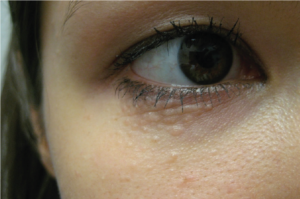
The above photo is of syringoma.
Causes and Characteristics of Syringoma Syringoma is a benign skin tumor originating from eccrine sweat glands. The exact cause and mechanism of syringoma’s occurrence are not fully understood. It typically manifests as numerous small flesh-colored bumps on the lower cheek or upper eyelid. It is more common in women and particularly appears around the eyes.
Reasons for Syringoma’s Prevalence Around the Eyes
①Sweat gland distribution: The area around the eyes has a high concentration of eccrine sweat glands. Since syringoma arises from these glands, it tends to occur frequently around this area.
②Skin thinness: The skin around the eyes is thinner compared to other parts of the body. This means even minute changes or small tumors like syringoma are more noticeable.
Relationship Between Syringoma and Hormones
While the exact cause of syringoma is still unknown, fluctuations in female hormones might play a role. There have been reports of syringoma cases during times of significant hormonal changes, such as puberty, pregnancy, or menopause. Some studies suggest that estrogen, a female hormone, may influence eccrine sweat glands, possibly promoting the development of syringoma.
Distinguishing Syringoma from Eccrine Hidrocystoma, Milia, and Sebaceous Hyperplasia Syringoma can be easily confused with eccrine hidrocystoma, milia, and sebaceous hyperplasia, all of which can appear as grainy skin bumps around the eyes. However, a specialist can distinguish them based on the following differences:
Color and Shape: Syringoma appears as semi-transparent, flesh-colored bumps, while eccrine hidrocystoma has a clear or bluish tint. Milia are hard white or flesh-colored nodules, and sebaceous hyperplasia manifests as yellowish or flesh-colored papules.
Texture: Syringoma is firm to the touch, eccrine hidrocystoma is soft and mobile, and milia are hard.
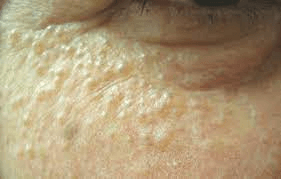
The above photo is of eccrine hidrocystoma.
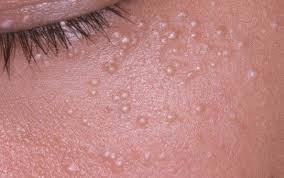
The above photo is of milia.
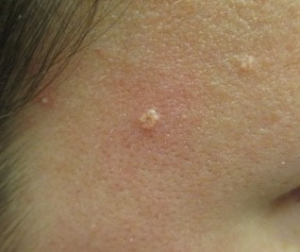
The above photo is of sebaceous hyperplasia.
Treatment for Syringoma While syringomas are benign and typically don’t require treatment, some might seek remedies due to cosmetic concerns.
□Electrocautery: A method that uses a small electrical current to burn and remove the tumor.
□Laser treatment: Using CO2 or Erbium lasers to evaporate syringoma.
□Surgical excision: Directly removing the tumor surgically.
□Peeling: Using TCA (Trichloroacetic acid) for a light skin peel to reduce the tumor.
Latest Treatment: Agnes Treatment
The Agnes Radiofrequency (RF) treatment is gaining popularity. This device can precisely deliver RF energy to specific skin depths, selectively causing thermal injury to syringoma tissues, leading to coagulation and destruction. The downtime is relatively short, and its effects are considered long-lasting.
Conclusion
While syringoma is a benign skin tumor and poses a low health risk, many might be self-conscious about its appearance. By selecting the most appropriate treatment method, such as the Agnes treatment, one can effectively address syringoma and lead a more confident life.
Written by Kenta Motogami, M.D.
Director of Funabashi Chuou Clinic (Chiba Pref. Japan) ana Aoyama Celes Clinic (Tokyo)
English is available at these clinics.
【Related Articles】
The Mysteries of Syringoma: Understanding Its Nature and the Innovative Treatment “Agnes”
“Bumps Around the Eyes: What Are They? ②Could it beMilia?”
“Bumps Around the Eyes: What Are They? ③Could it be Eccrine Hidrocystoma?”
Bumps on the face: What are these? Could it be Sebaceous Gland Hyperplasia?
カテゴリーから探す
- 目
- 鼻
- プチ整形
- その他の顔の治療
- 美肌治療
- にきび治療
- アンチエイジング・若返り
- 小顔・輪郭治療
- 豊胸・バスト
- 痩せる方法
- 院長日記
- わきが・多汗症
- タトゥー除去
- 女性の薄毛
- レーザー脱毛
- ほくろ・いぼ除去
- その他
- Articles in English
最新記事
アーカイブから探す
タグ一覧
千葉エリアで治療をご希望の方はこちら
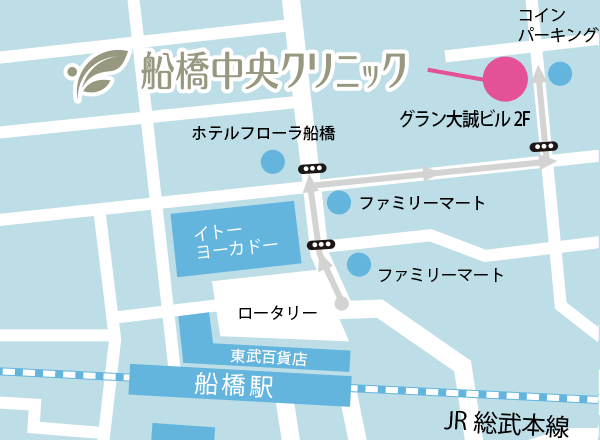
〒273-0005
千葉県船橋市本町6-4-15
グラン大誠ビル 2F
責任者:元神賢太
最終学歴:H11年慶応義塾大学医学部卒業
勤務歴:H15年船橋中央クリニック開業
東京エリアで治療をご希望の方はこちら
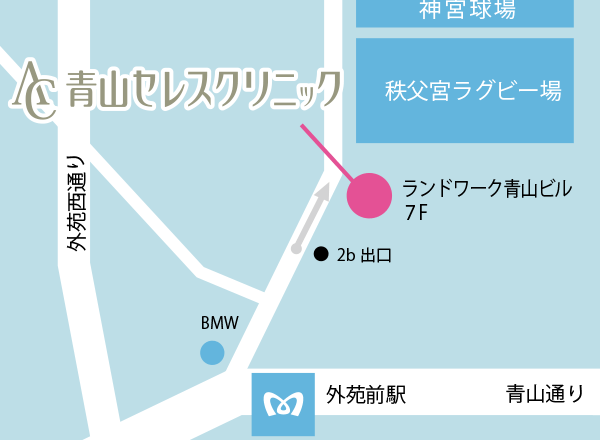
〒107-0061
東京都港区北青山2-7-26
ランドワーク青山ビル7F
(旧ヒューリック外苑前ビル)
責任者:高林洋一
最終学歴:S43年慶応義塾大学医学部卒業
勤務歴:H28年青山セレスクリニック管理者











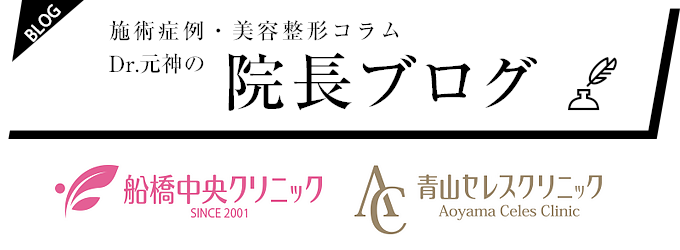
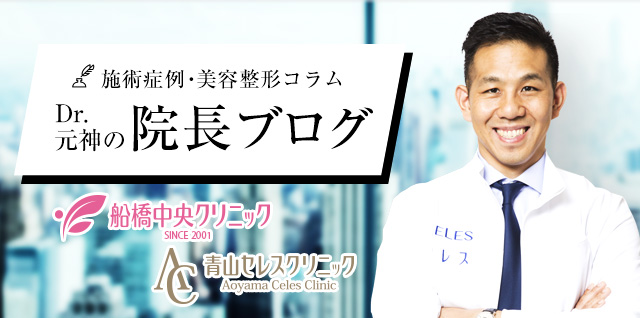


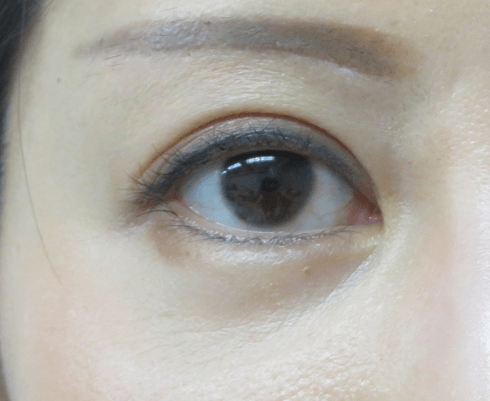

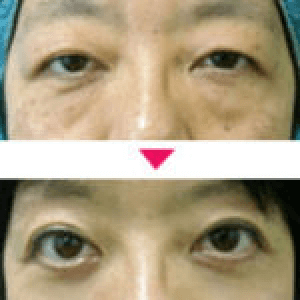
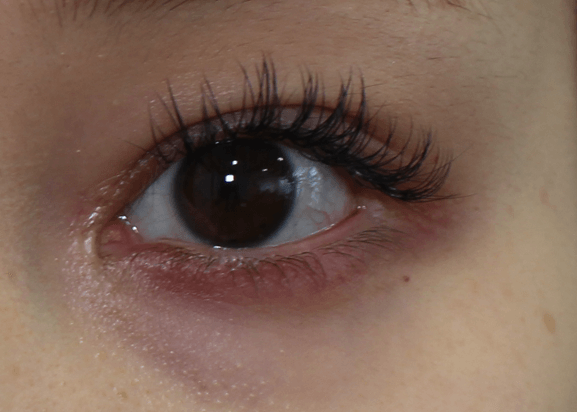
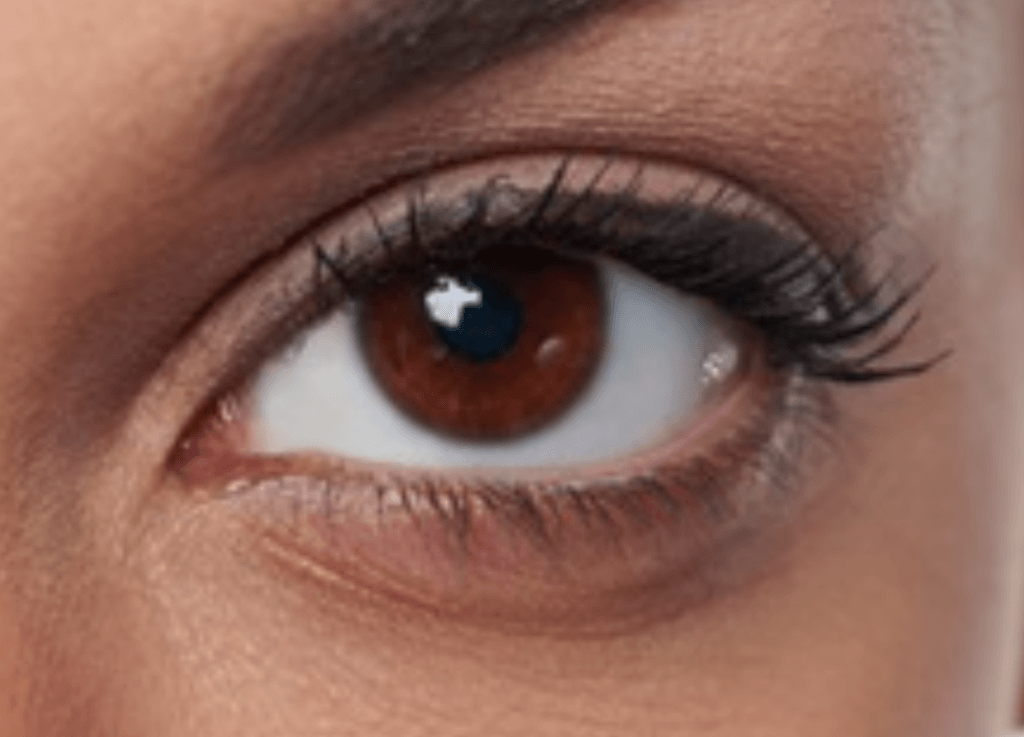
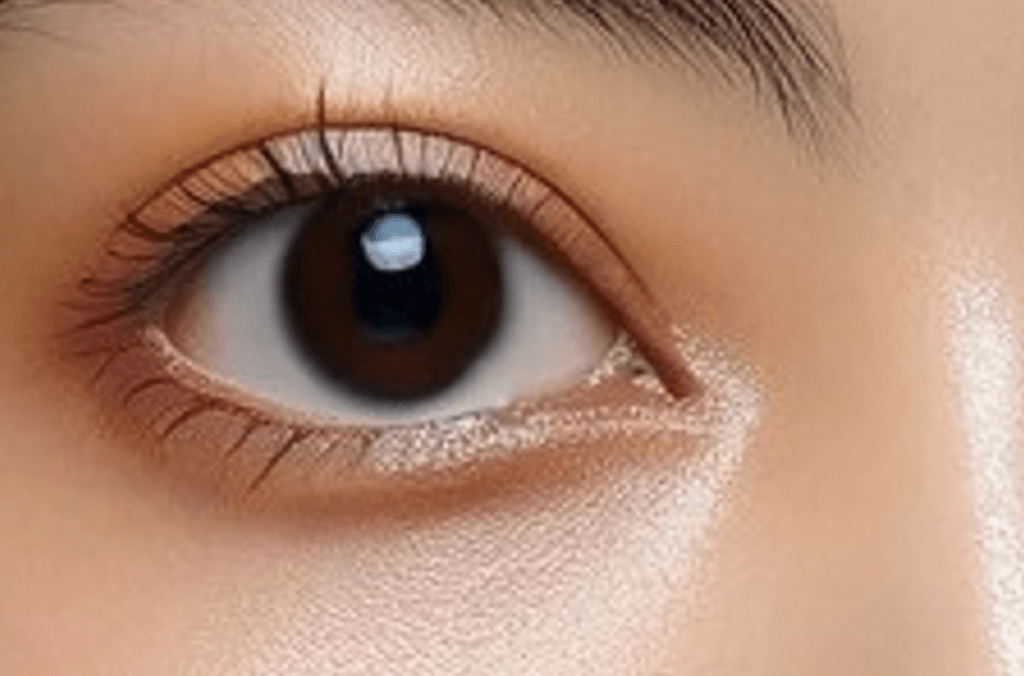
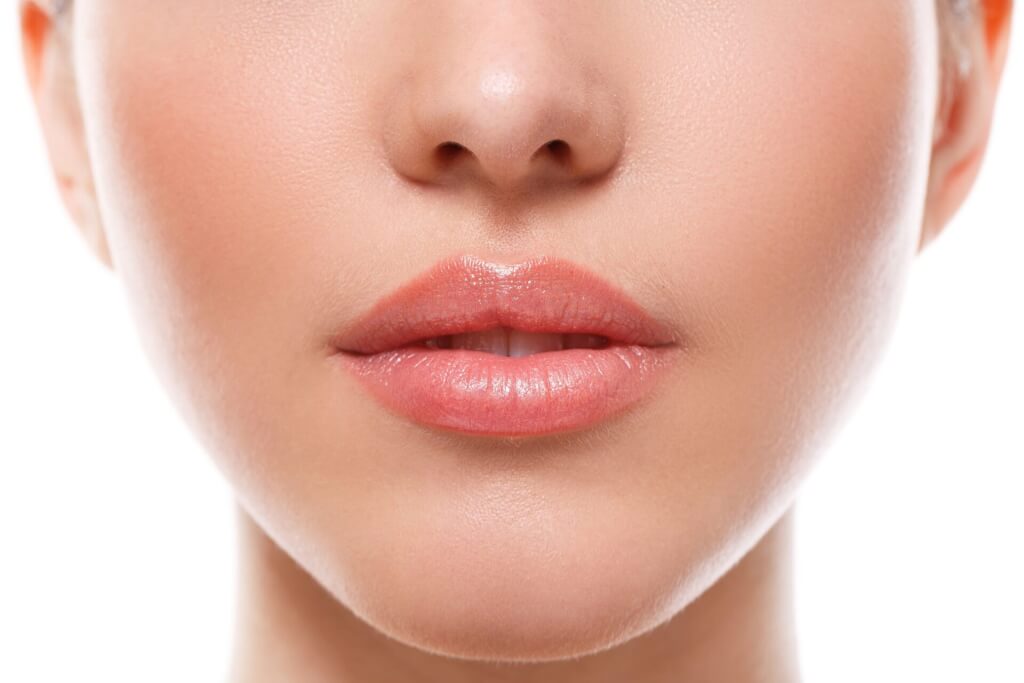




















 フリーダイヤル
フリーダイヤル
